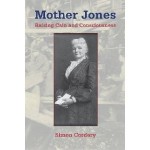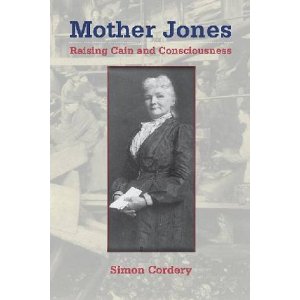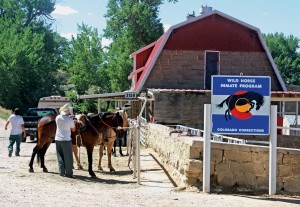By Simon Cordery
Published in 2010 by University of New Mexico Press
ISBN 978-0-8263-4810-4
$21.95 paperback; 224 pages
Reviewed by Virginia McConnell Simmons
Social, political, and economic gulfs that are seldom probed in depth by popular histories exist between the mansions of mining kings in cities and the shacks of anonymous miners in ghost towns. This new biography of Mother Jones will offer readers an understanding of the underlying issues, attitudes, and clashes in strikes and elections.
From her childhood in Ireland during the potato famine and the deaths of her husband and four children from yellow fever in Tennessee, to her attempted challenges of John D. Rockefeller, Jr., and President Woodrow Wilson when she was in her eighties, her life was never prosaic. Shattering the image of females of a century ago when their proper place supposedly was in their homes, Mary Harris “Mother” Jones appeared conspicuously wherever labor unrest existed in the nation between the 1890s and the 1920s, and at earlier violent strikes too if her own claims can be trusted. As her biographer Simon Cordery, associate professor of history at Monmouth College, points out, however, some of her own statements are implausible and some popular information about her personal and public life cannot be verified, but the known facts reveal sufficient courage and flair to comprise a colorful tale.
Particularly as a paid organizer and agitator for the United Mine Workers of America (UMWA) with occasional service in the Socialist Party as well, she was a well-known, radical gadfly. Without explanation of her fame or ubiquity, Mother Jones is mentioned in many Colorado histories about Cripple Creek and Ludlow. Usually she is described as slipping in and out of the grasp of authorities on trains at Trinidad, Walsenburg, and Denver, but little more.
With a focus on both her life and times, author Cordery places Mother Jones and her career in the broader context of the labor movement. In the process, he gives us a scholarly, yet very readable narrative, shedding light on railroad, streetcar, and textile strikes of the period; historic strikes in coal mines of Pennsylvania and West Virginia; Bunker Hill in Idaho, the murder of Governor Steunenberg, and trial of Big Bill Haywood et al.; women’s involvement in the reform movement; class warfare; Socialism; Eugene Debs.
Another recent and highly recommended volume about labor history is David R. Berman’s Radicalism in the Mountain West, 1890-1920, which has been reviewed here in the past. He contributed several details about Mother Jones, the Western Federation of Miners at Cripple Creek, the United Mine Workers in southern Colorado’s coalfields in 1903-1904, and the labor war of 1913-1914. Berman discussed the rumors about Mother Jones’s previous occupation in prostitution that, he claims, were made to blunt her influence, a point that Cordery overlooks. Berman also reported that when the militia deported her from Colorado along with miners and other organizers in 1904, she was quarantined in Utah, allegedly for having been exposed to smallpox, possibly as a way to control her.
Berman also illutrated her influence among women by describing in greater detail her incarceration for nine weeks at Mt. San Rafael Hospital in Trinidad, at the time of the Ludlow strike and tragedy. Her imprisonment only increased her popularity, especially among women, as demonstrators with children in tow marched through the streets of Trinidad to show their support.
Both authors give information about the birth of the radical Industrial Workers of the World (IWW or Wobblies) in 1905 at Chicago, where Mother Jones attended the convention. Socialists of Mother Jones’s stripe ultimately split from the more extreme, revolutionary IWW, but she still espoused the principle that the workers who produced industrial wealth should be the owners of the industries.
As Berman stated: “The region – encompassing the states of Arizona, Colorado, Idaho, Montana, Nevada, New Mexico, Utah, and Wyoming – from 1890 to 1920 was a bed of radical activity on both the political and industrial (economic) fronts. The radicals wanted not to simply reform the capitalist system but to replace it with something they felt was better, be it a cooperative commonwealth or a system of industrial democracy built around one big union.”
With her brogue, grandmotherly appearance, inflammatory speeches, and folksy blandishments, Mother Jones was sure to draw a crowd and inspire support for the UMWA as the one big union in the coal mines.


